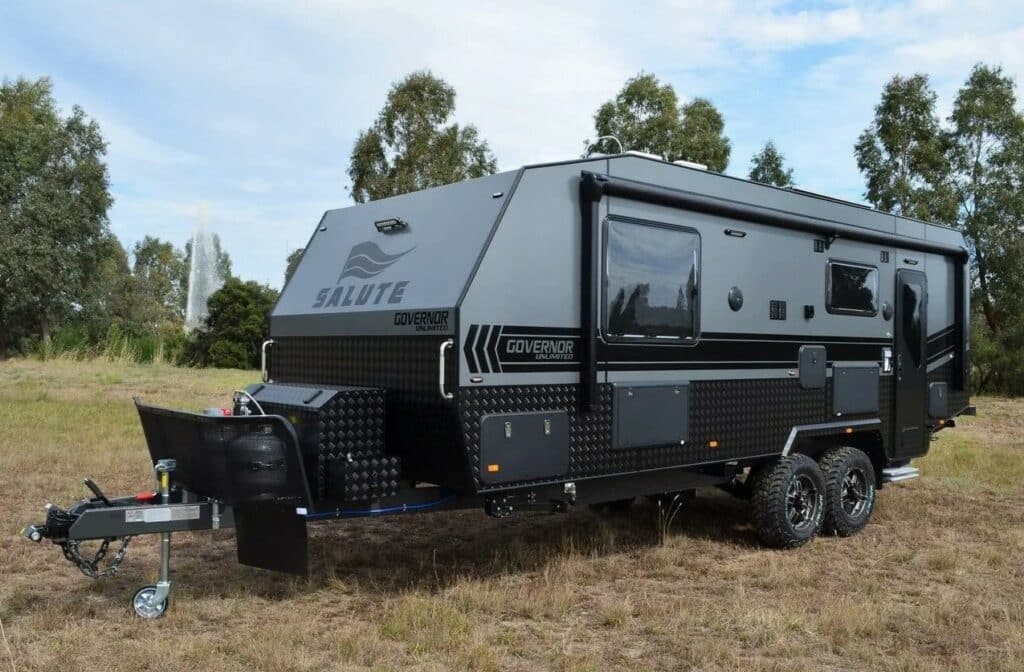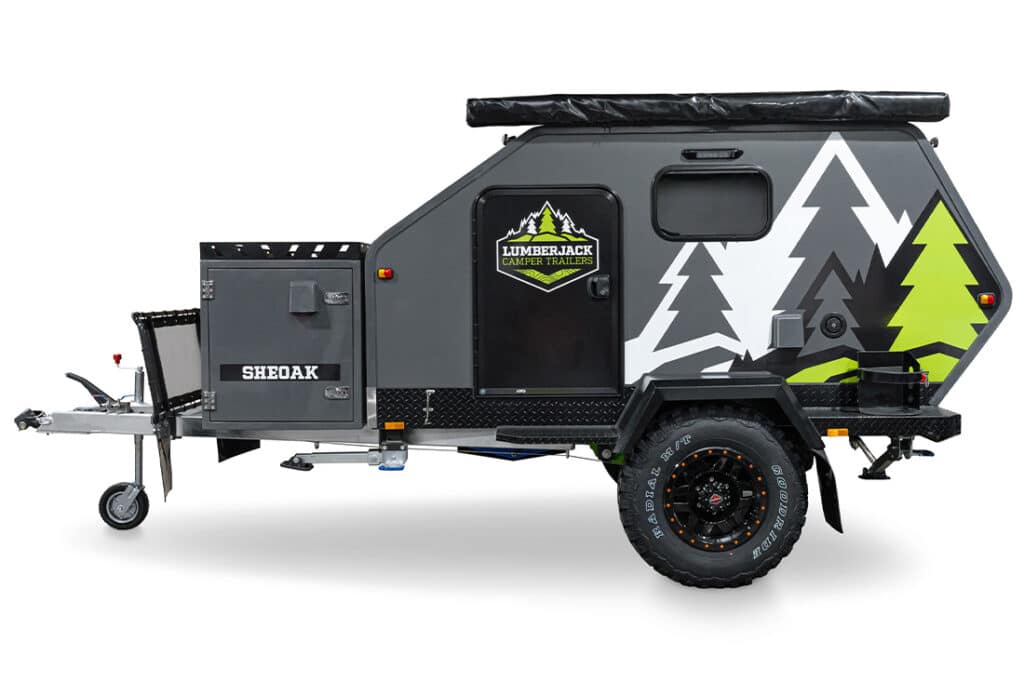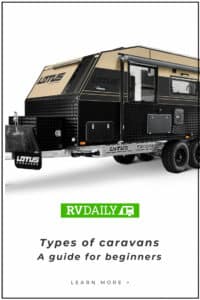Types of caravans in Australia: A guide for beginners




Caravanning is a big deal right now, and if you’re reading this, you obviously understand the appeal of hitting the road as much as we do. However, with so many different types of caravans in Australia, it’s hard to know where to start looking.
What types of caravans are there in Australia? What should I look for when buying one? Which one will suit my needs and budget? What brands are there? What are the top 10 I should look at for a particular type of caravan? All of these are common questions, and we’re going to answer them in a series of articles aimed at helping you choose the best caravan for you.
In this article, we’ll start with the basics of the different types of caravans in Australia and the brands that make them. Future articles in this series will cover what to look for when buying a caravan and comparisons of models.

A full-sized or ‘regular’ type of caravan in Australia features full-height solid walls (it doesn’t pop up) and a solid roof. No canvas is used in the construction of the caravan unless you count the awning, and it could have anywhere between one to three axles.
Although the average length is 5.8m (19ft) for this type of caravan, it should be noted that full-sized caravans vary greatly in size and can be manufactured much shorter or much longer. In Australia, the overall length of the caravan and vehicle combination must not exceed 19m.
Full-sized caravans usually have everything you need inside, including air conditioning, a kitchen, a dinette and most likely an ensuite. Bedding options vary from two to five or more. The larger ones may even have a washing machine, a separate shower and toilet, a separate lounge and dining room and bunk beds.
Pop-tops are a popular type of caravan in Australia and usually have all the features of a regular caravan, except they don’t have full-height walls. Instead, they ‘pop up’ for extra height when you park and set up camp.
The major benefit to this type of caravan is that it has a lower travel height and therefore, reduces wind drag. The other plus is that you can get a higher-than-normal internal height with a pop-top caravan, making it an ideal choice for tall people.
The pop-up section in this type of caravan is constructed from canvas and varies from where it pops up, either featuring canvas at head height like the Jayco Journey or canvas walls like the Jayco Penguin. The majority of pop-up caravans with canvas walls don’t feature an ensuite. However, the upside to more canvas is that the more there is to pop up, the lower your caravan will pack down for ease of towing and storing.
Slide-out caravans have a section of wall that slides out either at the bed end or on the side of the RV to give extra living space. The slide-out section can either be canvas or the same solid materials from which the rest of the caravan is constructed. The walls on this type of caravan are often full height but can also be a small pop-top.
The major benefit to the bed end sliding out is that the towing length can be kept to a manageable size while still providing plenty of living space. New Age’s Explore XU is a good example of this. The plus to having a side wall that slides out is that it increases the living area and is often electronic, so minimal effort is required to slide it out. New Age’s Big Red is a good example of this. Wall slide-out caravans are often at the top end of the market.
A pop-top slide-out caravan is exactly how it sounds, a marriage of both types of caravans. The slide-out in a pop-top slide-out is always at the bed ends, making them more compact than most when packed up for travel. The Jayco Expander Outback and Jayco Swan in the images above are both great examples of this type of caravan.
The major benefits of these are ease of towing and a spacious interior.

If a caravan and a camper trailer got together and had a baby, the hybrid caravan is what you would get. It has hard, permanent walls like a caravan but with the suspension and towing ability of a camper trailer. As a result, it fills a large gap in the market for those who want the comfort of a caravan but also want to head off-road. It’s no surprise that hybrid caravans have exploded in popularity.
Many hybrids also feature a pop-up roof and although they’re already comfortable, it’s not uncommon to see what was once considered luxury items such as an ensuite, TV and air-conditioning. Most have an outdoor kitchen on a slide-out.

Teardrop caravans have somewhat of a nostalgic appeal in appearance, featuring solid walls and a small, aerodynamic towing profile. The kitchen is usually in the rear on a slide-out and there is no room for an inside bathroom. There’s enough room for a bed, a TV and some storage inside, and while you can sit up, you definitely won’t be able to stand up in a teardrop caravan.
They’re designed for singles and couples who don’t want the hassles of a larger van, but some are designed to handle weight on the roof, so it’s not uncommon for families to use them with a rooftop tent.

Pod caravans have also exploded in popularity and you can think of them like a hybrid that resulted from a teardrop caravan and a camper trailer. They have the underpinnings of a teardrop caravan but are also capable going off-road and often off-grid too. As a result, they sit comfortably in both the caravan and camper trailer category.
They have all the features of a teardrop caravan but are usually more boxy in shape and ready to go off-road and off-grid for longer.

Fifth-wheelers are a popular type of caravan in the USA, and while the concept has been around for a long time, they only started appearing in numbers in Australia in the early 1990s. They have long been the caravan of choice for those carting horses around.
Fifth-wheelers are the largest type of caravan available in Australia and require a special hitch (fifth-wheel) to be installed onto the back of your vehicle. They hitch up similar to how a semi-trailer attaches to a cab and as a result, you must have a vehicle that can legally tow your fifth-wheeler. Basically, you can’t just go and install the hitch on any old ute.
They’re certainly large enough to be comfortable, literally a home on wheels. However, this also comes with some negatives, such as the weight and size. Not all campgrounds will have the space for a fifth-wheeler which, these days, often have slide-outs as well. In saying that, you can certainly get fifth-wheelers that are just ‘normal’ size too.
In terms of towing this type of caravan, the different style of hitch is much safer and easier to tow once hooked up. This is because of the way the weight is loaded onto the tow vehicle, with the weight directly on the bed of the pickup and not behind it.

Toy haulers are basically full-size caravans with a garage in the back for ‘toys’ such as dirt bikes, kayaks, mountain bikes etc. It’s a bit like a mullet, party in the back and business in the front.
Some people buy toy haulers not to haul toys but to convert the garage into either a separate room for kids or an office. Bunk beds can be hinged onto the walls in the garage for those that wish to do both!
Off-road caravans are purpose-built to withstand the rigours of hitting the rough stuff and most caravan manufacturers have off-road optional upgrades for the different types of caravans they sell.
An off-road caravan will generally come with extra ground clearance, heavy-duty chassis, heavy-duty suspension (coils or airbags), upgraded brakes, an articulated hitch and larger mud or all-terrain tyres. Caravans built for off-road also often come with extras for staying off-grid longer, such as increased water storage, upgraded battery systems and solar panels.
It’s important to note that some off-road caravans are sold as semi-off-road, sitting somewhere between the extremes of an on-road caravan and a fully kitted out off-road caravan.
However, just because a caravan has these upgrades doesn’t mean it’s designed for 4WDing through tight tracks. You still need to take the size and weight of your caravan into consideration before you head off-road. If you really want to tackle serious 4WD tracks, you’ll probably need to look at a hybrid or camper trailer manufacturers that specialise in off-road RVs.
In addition to caravans, but still falling under the banner of RVs (Recreational Vehicles), we also have camper trailers, motorhomes and campervans. And given that there are multiple types of these as well, this is a topic for another day. We’ll be creating a series of articles on these RV types as well. Stay tuned!
Stay tuned for our next article in this series on what to consider when buying your first (or third) caravan.
